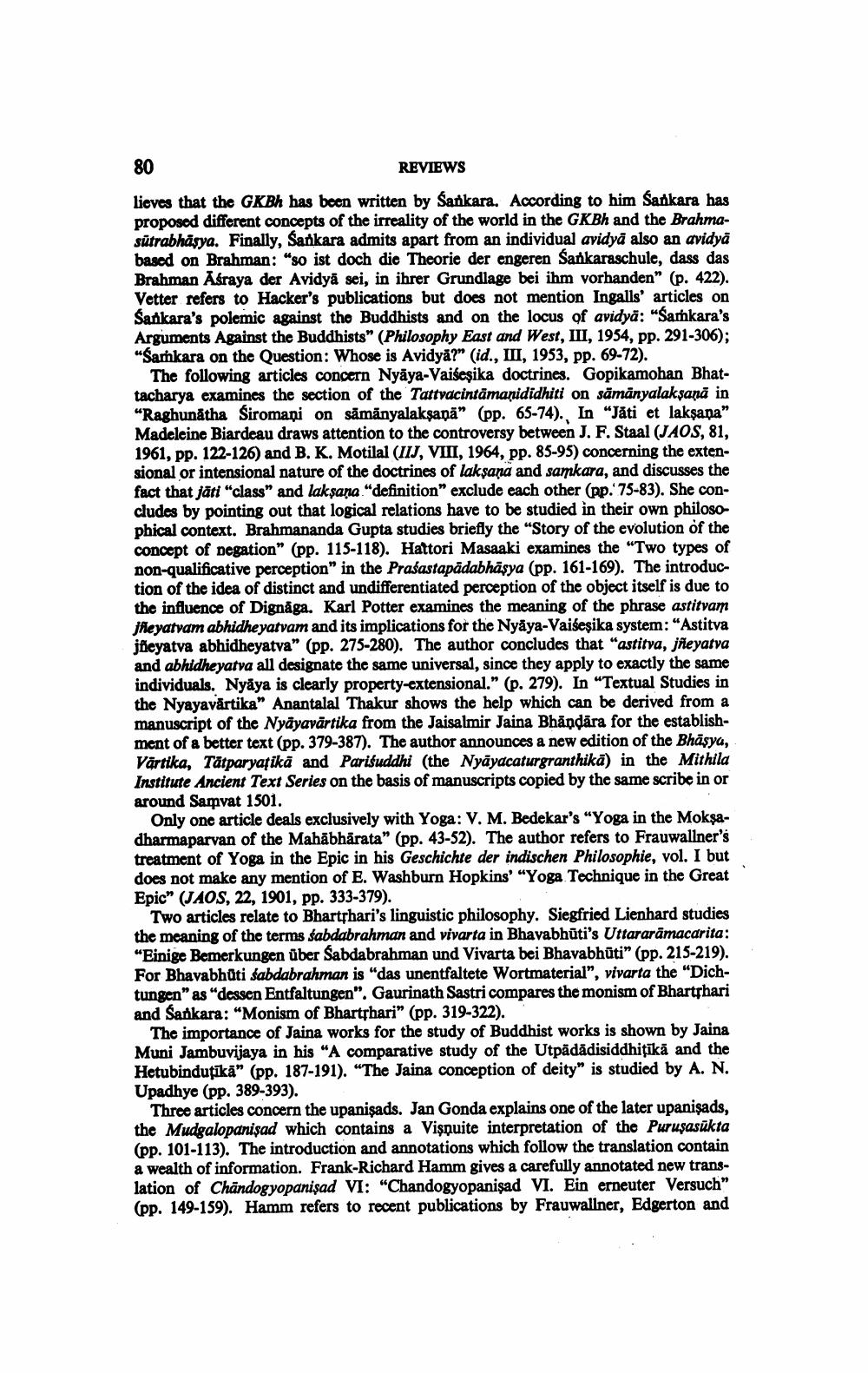Book Title: Reviews Of Different Books Author(s): Publisher: View full book textPage 4
________________ 80 REVIEWS lieves that the GKBh has been written by Sankara. According to him Sankara has proposed different concepts of the irreality of the world in the GKBh and the Brahmasutrabhasya. Finally, Sankara admits apart from an individual avidya also an avidya based on Brahman: "so ist doch die Theorie der engeren Sankaraschule, dass das Brahman Asraya der Avidya sei, in ihrer Grundlage bei ihm vorhanden" (p. 422). Vetter refers to Hacker's publications but does not mention Ingalls' articles on Sankara's polemic against the Buddhists and on the locus of avidya: "Sarkara's Arguments Against the Buddhists" (Philosophy East and West, III, 1954, pp. 291-306); "Sarkara on the Question: Whose is Avidya?" (id., III, 1953, pp. 69-72). The following articles concern Nyaya-Vaisesika doctrines. Gopikamohan Bhattacharya examines the section of the Tattvacintamanididhiti on samanyalaksana in "Raghunatha Siromani on samanyalaksana" (pp. 65-74). In "Jati et laksana" Madeleine Biardeau draws attention to the controversy between J. F. Staal (JAOS, 81, 1961, pp. 122-126) and B. K. Motilal (IIJ, VIII, 1964, pp. 85-95) concerning the extensional or intensional nature of the doctrines of laksana and samkara, and discusses the fact that jati "class" and laksana "definition" exclude each other (pp. 75-83). She concludes by pointing out that logical relations have to be studied in their own philoso phical context. Brahmananda Gupta studies briefly the "Story of the evolution of the concept of negation" (pp. 115-118). Hattori Masaaki examines the "Two types of non-qualificative perception" in the Prasastapadabhasya (pp. 161-169). The introduction of the idea of distinct and undifferentiated perception of the object itself is due to the influence of Dignaga. Karl Potter examines the meaning of the phrase astitvam ifleyatvam abhidheyatvam and its implications for the Nyaya-Vaisesika system: "Astitva joeyatva abhidheyatva" (pp. 275-280). The author concludes that "astitva, jneyatva and abhidheyatva all designate the same universal, since they apply to exactly the same individuals. Nyaya is clearly property-extensional." (p. 279). In "Textual Studies in the Nyayavartika" Anantalal Thakur shows the help which can be derived from a manuscript of the Nyayavartika from the Jaisalmir Jaina Bhandara for the establishment of a better text (pp. 379-387). The author announces a new edition of the Bhasya, Vartika, Tatparyatika and Parisuddhi (the Nyayacaturgranthika) in the Mithila Institute Ancient Text Series on the basis of manuscripts copied by the same scribe in or around Samvat 1501. Only one article deals exclusively with Yoga: V. M. Bedekar's "Yoga in the Moksadharmaparvan of the Mahabharata" (pp. 43-52). The author refers to Frauwallner's treatment of Yoga in the Epic in his Geschichte der indischen Philosophie, vol. I but does not make any mention of E. Washburn Hopkins' "Yoga Technique in the Great Epic" (JAOS, 22, 1901, pp. 333-379). Two articles relate to Bharthari's linguistic philosophy. Siegfried Lienhard studies the meaning of the terms sabdabrahman and vivarta in Bhavabhuti's Uttararamacarita: "Einige Bemerkungen uber Sabdabrahman und Vivarta bei Bhavabhuti" (pp. 215-219). For Bhavabhuti sabdabrahman is "das unentfaltete Wortmaterial", vivarta the "Dichtungen" as "dessen Entfaltungen". Gaurinath Sastri compares the monism of Bhartphari and Sankara: "Monism of Bharthari" (pp. 319-322). The importance of Jaina works for the study of Buddhist works is shown by Jaina Muni Jambuvijaya in his "A comparative study of the Utpadadisiddhitika and the Hetubindutika" (pp. 187-191). "The Jaina conception of deity" is studied by A. N. Upadhye (pp. 389-393). Three articles concern the upanisads. Jan Gonda explains one of the later upanisads, the Mudgalopanisad which contains a Visnuite interpretation of the Purusasukta (pp. 101-113). The introduction and annotations which follow the translation contain a wealth of information. Frank-Richard Hamm gives a carefully annotated new translation of Chandog yopanisad VI: "Chandogyopanisad VI. Ein erneuter Versuch" (pp. 149-159). Hamm refers to recent publications by Frauwallner, Edgerton andPage Navigation
1 2 3 4 5 6 7 8 9 10 11 12 13 14 15 16 17 18
